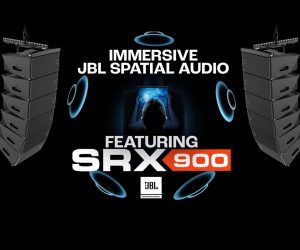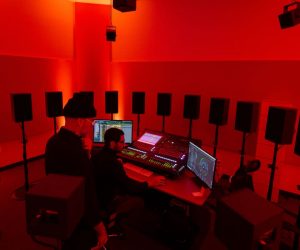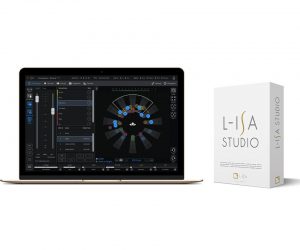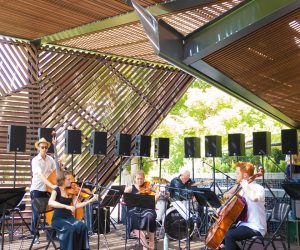
Spatial Audio Now
We caught up with Meyer Sound’s spatial audio czar, Steve Ellison, to take the temperature of the industry: where’s live sound spatial audio currently at?
Photos: Brian Livingstone
AT: I think I’m right in saying Meyer Sound was one of the first to market with what we now call spatial audio. Well before Spacemap Go.
Steve Ellison: Las Vegas is really an appropriate place for this conversation [for the InfoComm24 show]. We cut our teeth here with the shows in the ’90s. Our first deployment of a spatial audio solution was for ‘Starlight Express’ at the Hilton, which ran for years starting in 1993. Later that year, Cirque du Soleil’s ‘Mystère’ opened and is still running today. Jonathan Deans was the sound designer. We started a company in 1992 called Level Control Systems, which later became part of Meyer Sound.
AT: Right. There’s also an Australian connection, isn’t there?
Steve Ellison: Oh, yeah. Well, even before that — I was in Australia in 1986, in Canberra. I was working with a group of artists and technologists who had created an immersive venue for computer-enabled spatial music and video. It was a geodesic dome, designed to be portable, and inside it had five projection screens and 16 loudspeakers arranged in three rings of five, with one speaker overhead. I was developing generative algorithms for computer music, which included figuring out where the sound would be positioned in space. That led me to work out the math for what later became Spacemap.
AT: Which has been part of many shows in Vegas, like ‘Mystère’ and others, right?
Steve Ellison: Exactly. Spacemap became a core tool for controlling sound in those shows. It all started from those experiments in Australia, and we developed it into a product that has been used in shows like Mystère and now at Sphere.

Steve Ellison (right) mixing the music of Jim Lang (left) with Spacemap at Moogfest 2019.
SPACEMAP ORIGINS
AT: When you developed Spacemap and turned it into a product, what were your expectations? It seems like you came from a more avant-garde, experimental side of spatial sound.
Steve Ellison: Good question. You’re right — it did come from avant-garde roots. But when I started working with Jonathan, I was introduced to the theatrical sound world. We had to develop software and hardware that could control sound in large-scale productions. Spacemap became one of those components where you could write a cue and say, “I want this sound to move from here to there along this path.” Throughout the 1990s, we honed that process as we moved from analogue to digital, and then to DSP systems. Our first major product was the LCS Analog Series, a digitally controlled analogue matrix. We then created SuperNova, our first all-digital processor with embedded automation. Meyer Sound’s NADIA is our latest product to support Spacemap.
AT: And how did you get from those tightly controlled, pre-programmed shows to something more live, like what you did at Moogfest?
Steve Ellison: Moogfest was a turning point. In 2018, KamranV invited us to transform the Armory venue from stereo to immersive, showcasing nine artists over three evenings with minimal rehearsal time. In addition to the main PA, we used 22 surround and overhead speakers. We created a custom iPad interface to control Spacemap in D-Mitri, so sound mixers could mix spatially on the fly. Multiple iPads let them access all the channels at once. Watching a second-year student from Berklee College of Music mix an improvised score by synthesist Suzanne Ciani and her ensemble showed that live, interactive spatial sound was not only possible but incredibly engaging. We refined this in 2019, leading to Spacemap Go for Galaxy and now NADIA.

Moogfest 2019, which was a proving ground for an early version of Meyer Sound’s Spacemap Go spatial sound design and mixing tool.
ROLLING OUT SPATIAL VENUES
AT: Big strides have been made in pre-programmed spatial audio, but how do we speed up the process of bringing spatial sound to live venues on a more regular basis?
Steve Ellison: The key is making it accessible. Spacemap Go runs on our Galaxy processor, which is much more affordable than the systems we used in the past. We also worked on simplifying the user interface. But to get spatial sound into more venues, we need both artist buy-in and scalable technology.
Venues need to be future-proofed by putting in the right infrastructure — whether that’s wiring for networked audio or ensuring they have the right kind of loudspeaker setup. The next big step is getting more artists to think spatially. At Moogfest, we worked with artists like Mouse on Mars who were already experimenting with immersive sound. There’s a growing appetite for this among artists and audiences alike.
AT: You mentioned venues needing to be future-proofed. What advice would you give to a venue owner considering moving from stereo to spatial sound?
Steve Ellison: My advice to venue owners is to get the infrastructure in place early, even if you can’t afford the full system right away. Lay the groundwork for Ethernet or other networked systems, and design the space to accommodate a scalable loudspeaker setup. Partner with experts early in the process — whether that’s a sound designer or a manufacturer like us — because it’s a mix of science and art.
For artists, it’s a bit different. Many are already working with multi-track stems, and if they can keep control of those stems throughout the production process, they’ll be ready to explode them out into a spatial mix when the opportunity arises. Artists should start thinking about their production in spatial terms from the very beginning.
AT: Great. And what about from a technical perspective, how does a venue handle the transition?
Steve Ellison: From a technical perspective, it’s all about scalability. You don’t necessarily need 24 discrete channels like we had at Moogfest. For example, Ciani usually performs in quad, and as long as the loudspeaker systems are full range, wide dispersion, and set at the right height and downtilt, this will sound incredible. Our ULTRA series provides a flexible range of loudspeakers for various power and pattern control requirements. Our new flagship in this series, the ULTRA-X80, will make it easier to bring spatial mixes to even bigger audiences. Technology is becoming more accessible, all around. With these systems and Spacemap Go you can go from a quad setup to eight channels and beyond. So making the transition from stereo PA to quad includes selecting rear surround speakers that will work with the main PA, and then perhaps adding additional locations in between for higher resolution.
ELEVATOR SPATIAL PITCH
AT: So, to wrap up, what’s your elevator pitch to those who have the decision-making power to take the leap into spatial audio?
Steve Ellison: For venue owners, it’s about future-proofing your space. Install the right infrastructure now, and you’ll be able to support spatial sound for years to come. For artists, it’s about thinking spatially from the start — keep control of your stems and consider how your music can translate into an immersive experience. The demand for these experiences is growing, and the technology is more accessible than ever.
















RESPONSES